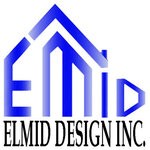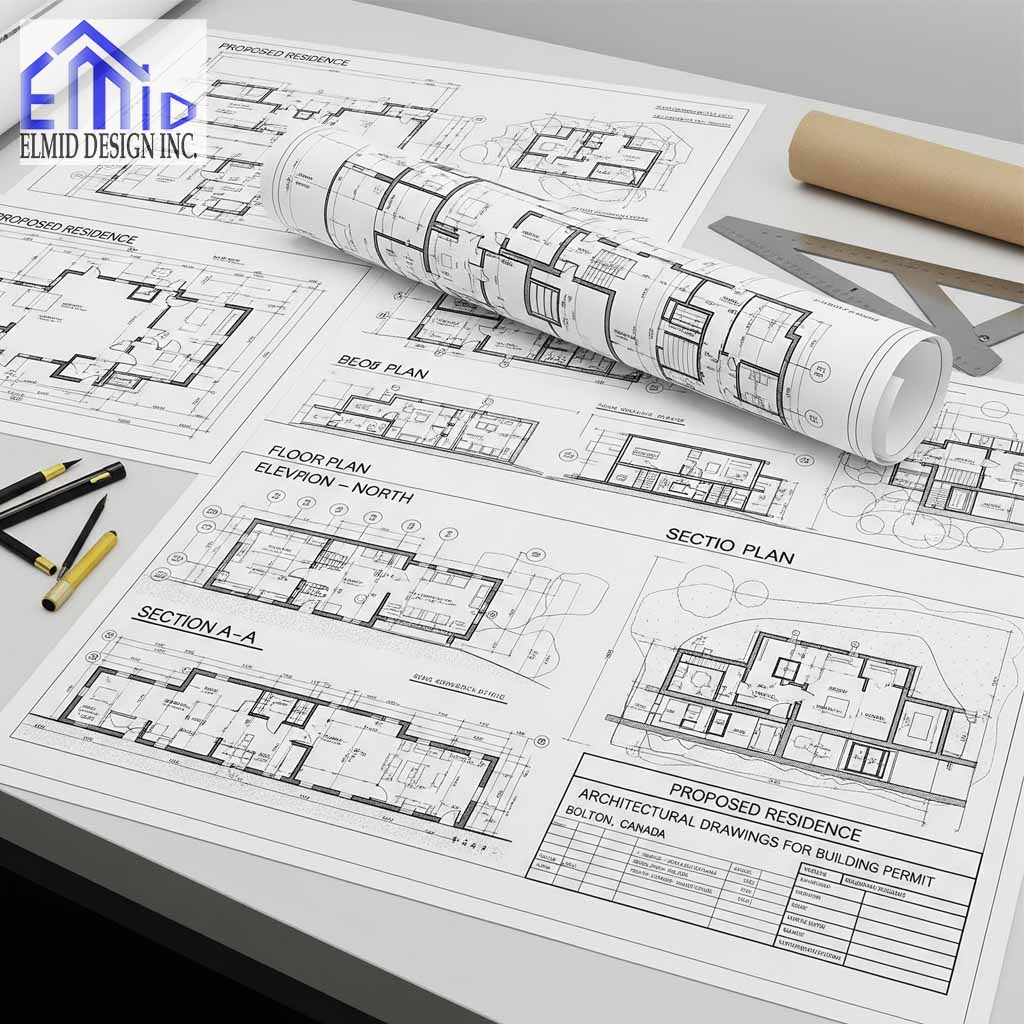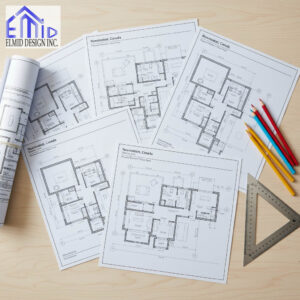Permit drawings in Bolton are crucial for any renovation or construction project because they ensure that your design aligns with the Ontario Building Code and municipal regulations while demonstrating your expertise. You will discover how to prepare the right documents, which services help you secure permits most efficiently, and what steps to follow for successful municipal approval.
Key Takeaways
Permit drawings in Bolton require precision, professional credentials, and compliance with the Town of Caledon guidelines.
Experienced local providers such as Acadia Drafting and Permit Works specialize in rapid, code-compliant permit packages.
You must include site plan, floor plans, elevations, sections, mechanical, plumbing, and other engineering or zoning‑specific documents.
Zoning, Niagara Escarpment oversight, and pre‑consultation options influence approval timelines.
Understanding Permit Drawing Essentials
When applying for a building permit in Bolton, your drawings must be to scale, fully dimensioned, signed and dated with designer credentials and BCIN included. The Town of Caledon demands site plan, floor plans, roof plans, elevation and section drawings, and mechanical and plumbing design details along with structural information and foundation specifics. These documents must be submitted in PDF following electronic submission guidelines.
What Drawings Are Needed for Bolton Applications
You must include a site plan showing property lines and setbacks, floor plans detailing interior layout and structural framing, roof plan illustrating trusses and ventilation, elevations showing exterior finishes and heights, sections showing assemblies and foundations, and mechanical/plumbing layouts with heat and ventilation calculations. Septic system design may also be required where applicable.
Zoning and Pre‑Consultation Considerations
You should check your zoning designation because it regulates land use, building placement, height, size, and parking. The Town of Caledon recommends scheduling a preliminary inquiry meeting with planning staff to identify potential issues before application so you can refine your plans and save time.
Permit Providers in Bolton
Acadia Drafting specializes in residential and commercial permit drawings in Bolton with over ten years of local experience. They deliver full permit-ready packages, including basement renovations, home additions, decks, laneway suites, commercial interiors, and mechanical drawings. Their typical approval timeline ranges from two weeks to three months. Permit Works offers architect‑led design services, unlimited revisions, free application submission, and boasts over two thousand approved permits. They provide upfront transparent pricing and fast revisions for smoother approvals.
Engineering‑Stamped Drawings for Complex Projects
For projects requiring structural, industrial, or specialized commercial permitting, plananddrawing.com provides engineering‑stamped drawings throughout Ontario, including Bolton. They ensure municipal compliance with site plan control, conservation authority, or MTO approvals when applicable.
What to Expect During Approval
The permit approval process relies on accurate documents and responsiveness to municipal comments. Providers such as Permit Works help by revising and resubmitting plans promptly. Approval timelines range from two weeks to several months based on complexity, zoning, and any required engineering reviews.
Real‑World Scenario: Basement Renovation
If you plan a basement renovation in Bolton, you must apply for an interior alterations permit. For building a secondary dwelling you’ll need a secondary unit permit. Underpinning for increased ceiling height requires an underpinning permit, and separate entrance construction needs a walk‑out permit. Acadia Drafting can support all these permit types.
Summarizing Permit Drawing Benefits
Clear, code‑compliant drawings increase your chance of quick approval. Using experts with local Bolton experience ensures you meet municipal requirements and can adapt to changes promptly. You will gain confidence, avoid delays, and ensure safety by engaging licensed professionals who know the process inside out.

Common Mistakes When Preparing Permit Drawings
Homeowners often underestimate the importance of precise details in permit drawings. Submitting incomplete or inaccurate documents causes delays, rejection, or additional fees. Some drawings lack proper dimensions or omit required structural components, which leads to municipal comments that extend the approval timeline. Others forget to include the BCIN or engineer’s stamp when required. You must also use the correct scale and format based on Town of Caledon electronic standards. Another major mistake involves overlooking zoning restrictions that affect height, lot coverage, and setbacks. Avoiding these errors demands hiring experienced designers who follow Ontario Building Code requirements and stay updated on local bylaw changes.
Step-by-Step Permit Drawing Process in Bolton
To start the process, define the scope of your project and identify if it requires structural changes or zoning relief. Then, choose a qualified service provider with local experience and verify their credentials. After initial consultation, your provider prepares scaled drawings including site plan, floor plans, and all code‑required sections. Submit these electronically to the Town of Caledon with completed application forms and fees. Monitor your email for comments and be ready to respond quickly with revisions. Finally, once approved, ensure the construction aligns with submitted plans during inspections. This workflow ensures compliance and prevents construction delays or penalties.
How Much Do Permit Drawings Cost in Bolton?
Permit drawing costs vary based on project complexity, property type, and service provider. For smaller residential jobs like decks or simple basement renovations, you may pay under one thousand dollars for standard drawings. More complex projects such as full home additions or legal secondary units often range from fifteen hundred to four thousand dollars depending on structural or engineering needs. Commercial permit drawings typically cost more due to zoning layers, HVAC integration, and occupancy requirements. You also must consider fees charged by the municipality for the permit itself. Getting multiple quotes helps clarify inclusions like application submission or revisions.
When Engineering Is Required for Permit Approval?
Some projects demand engineering‑stamped drawings, especially when modifying load‑bearing walls, excavating foundations, or adding new structural components. The Town of Caledon and Ontario Building Code both require a professional engineer’s review for underpinning, large additions, or any project that impacts structural integrity. Your drawing provider must include the seal of a licensed PEO‑authorized firm such as Elmid Design Inc, which holds a Certificate of Authorization from Professional Engineers Ontario. These credentials demonstrate both compliance and technical accuracy. Including engineering when required prevents rejection or dangerous construction outcomes and supports smoother approval.
Case Study: Legal Basement Apartment in Bolton
Converting a basement into a legal apartment involves many permit drawing layers. You must include floor plans showing separate entrance, kitchen, bathroom, living space, fire separation, and egress windows. Drawings must also detail HVAC separation, plumbing layout, and proper insulation to meet energy code. If the ceiling is low, underpinning may be needed, which then requires engineered drawings. The Town of Caledon considers this a secondary suite application, which comes with strict design and zoning requirements. Providers like Acadia Drafting and Elmid Design Inc help homeowners navigate these by offering complete permit drawing packages with engineer input when needed.
Timeline Expectations for Bolton Permit Approval
Once your permit drawings are submitted to the Town of Caledon, the review timeline varies depending on the project type and workload of municipal staff. Straightforward residential alterations like a deck or non‑structural basement finish may receive approval within ten to fifteen business days if documents are complete and accurate. However, structural renovations, secondary suites, or additions usually take between three to eight weeks for review. Projects requiring external approvals such as the Niagara Escarpment Commission or Conservation Authorities may take several months. Fast response to municipal comments from your designer or engineer can significantly reduce delays.
How Permit Drawings Affect Final Inspections?
Municipal inspections are directly based on your approved permit drawings. Any construction changes that deviate from submitted plans may result in failed inspections, work stoppages, or the need for revised drawings. Inspectors use these documents to verify that framing, insulation, ventilation, and fire safety systems meet the approved layout and building code standards. This is why accuracy in the initial drawings is crucial. If discrepancies are found, your project may be placed on hold until revised documents are reviewed and accepted. Working with experienced firms ensures that what you build matches what the inspector expects to see on‑site.
Comparing In‑House Architects vs Third‑Party Drafting Firms
Some homeowners choose in‑house architects offered by design‑build contractors while others hire third‑party drafting firms. In‑house teams may offer convenience and bundled pricing, but they often limit flexibility in design changes or permit strategies. Independent drafting firms such as Acadia Drafting or Permit Works specialize solely in permit drawings and code compliance. These firms often deliver faster turnaround and higher drawing precision. When structural elements are involved, third-party services can also coordinate directly with PEO‑licensed engineers like Elmid Design Inc for engineering stamps. This creates a more modular and transparent process especially for projects requiring complex zoning or multiple revisions.
When to Start Planning Permit Drawings?
You should begin your permit drawing process as soon as you define the scope of your renovation or construction. Early planning allows time for zoning research, initial consultation with a designer, and pre‑consultation with planning staff if needed. Waiting until the last minute often causes rushed decisions, poor design outcomes, or lengthy delays due to back-and-forth revisions. For spring or summer construction starts, permit drawings should begin during the previous winter. This ensures time for drafting, municipal feedback, and engineering review if needed. Timely planning also gives you the flexibility to adjust to unforeseen regulatory or zoning constraints.
Why Trust is Critical When Choosing a Permit Provider?
Trust is foundational when selecting a company for permit drawings in Bolton. You are not just hiring a drafter but entrusting them with your home’s safety, legal compliance, and financial investment. Companies like Elmid Design Inc and Permit Works build trust through transparent pricing, responsive communication, and a history of successful municipal approvals. Their certifications, especially PEO authorization, reinforce credibility and show adherence to provincial engineering standards. Trustworthy providers also remain engaged post‑approval to assist during inspections or design changes. This ongoing support protects your project from delays and costly corrections later, making trust more valuable than the initial quote.
Benefits of Digital Submissions for Drawings
Digital permit submissions through the Town of Caledon’s ePermitting platform allow homeowners and contractors to upload drawings in PDF format for faster processing. This system eliminates printing costs and provides real-time tracking for your application’s status. Digital formats also support easier collaboration between your designer, engineer, and municipal staff. Changes can be made and resubmitted faster than with traditional paper processes. For larger or time-sensitive projects, digital access helps maintain momentum and reduce miscommunication. Professional firms like Acadia Drafting and Elmid Design Inc routinely prepare their drawing sets for digital compatibility to ensure smooth approval.
Navigating Conservation Authority and NEC Reviews
Some properties in Bolton fall within regulated areas controlled by the Toronto and Region Conservation Authority or the Niagara Escarpment Commission. These authorities review construction proposals for environmental impact, slope stability, and site grading. If your property lies within these zones, you must first obtain their written approval before the Town of Caledon will process your building permit. These extra layers add time and complexity to the process. Engaging a designer familiar with local mapping tools and these agencies ensures your permit drawings include required setbacks, drainage plans, or erosion control designs. Elmid Design Inc frequently prepares submissions that meet these specialized agency standards.
Understanding Permit Revisions and Resubmissions
Permit drawings sometimes require multiple rounds of revision before final approval. This may result from missing technical details, changes in design scope, or municipal comments requesting clarification. Each resubmission must follow Caledon’s electronic guidelines and include a written summary of changes to help expedite review. Professional providers track all feedback and integrate it into updated drawings without compromising overall design integrity. Fast resubmissions depend on responsive communication between the homeowner, designer, and municipal reviewer. Providers like Permit Works often include revision services within their package, helping you avoid surprise fees or long wait times during this phase.
Legal Implications of Building Without a Permit
Constructing without an approved permit in Bolton violates the Ontario Building Code and local bylaw enforcement policies. If work begins before permit issuance, you may face stop-work orders, fines, forced demolition, or legal action. Insurance providers may also refuse to cover damages for unauthorized construction. The municipality may require retroactive applications with detailed as-built drawings, which often cost more than starting with proper planning. Homeowners who cut corners on permit drawings expose themselves to serious financial and legal risks. Hiring firms like Elmid Design Inc and following the correct submission process ensures full compliance and long-term peace of mind.
Impact of Permit Drawings on Property Resale
Accurate and approved permit drawings can improve your home’s resale value by documenting legal upgrades and code-compliant changes. Buyers often request records of renovations and look for evidence that permits were obtained for finished basements, additions, or new entrances. Real estate agents and legal advisors emphasize the importance of documented compliance when preparing listing documents. Incomplete or unpermitted work can reduce buyer interest or delay closing. For this reason, homeowners benefit from keeping digital copies of all approved drawings and final inspection reports. Services like Permit Works and Acadia Drafting offer packages that include electronic storage for future reference.
Importance of Site Grading in Permit Submissions
Site grading plays a crucial role in permit drawing packages for additions, garages, and new builds. The Town of Caledon requires elevation data to confirm that water runoff will not impact adjacent properties. Grading drawings must include existing and proposed elevations, drainage direction, and spot elevations at building corners. Professional designers use survey data or create grading plans that adhere to engineering standards. Elmid Design Inc includes this service in their packages when needed, which ensures full compliance with stormwater and lot drainage policies. Poor or missing grading documentation can cause delays, especially in flood-prone or sloped areas.
Frequently Asked Questions
What happens if my drawings don’t meet zoning rules in Bolton?
If your permit drawings do not meet zoning regulations, the municipality may issue comments requesting revisions or reject the application. You may need to apply for minor variances through the Committee of Adjustment. Consulting with a designer familiar with local zoning before submission helps prevent this issue and saves significant time.
Can I modify my project after permit approval?
Yes, but any significant changes to your approved plans require submitting updated drawings for municipal review. Proceeding without official updates may lead to inspection failures or stop-work orders. Always consult your permit provider before making structural or layout modifications during construction.
Do all projects in Bolton require engineering-stamped drawings?
Not all projects need engineering stamps. However, structural changes like beam removal, foundation work, or additions do require an engineer’s approval. Firms such as Elmid Design Inc can evaluate your project scope and determine whether an engineering stamp is necessary for compliance.
Are permit drawings reusable for future renovations?
Permit drawings are specific to the project and location they were approved for. Reusing them for a different renovation or property is not allowed. Any new project requires fresh drawings that reflect current conditions and bylaw standards. Some drawing components like layout ideas may be referenced but must be redrafted for a new application.
How do I verify if my provider has proper licensing?
You can check their BCIN through Ontario’s Ministry of Municipal Affairs and Housing directory. For engineers, verify authorization through the Professional Engineers Ontario (PEO) website. Providers like Elmid Design Inc clearly display their Certificate of Authorization which ensures professional accountability and code adherence.

Why Elmid Design Inc Is Bolton’s Trusted Permit Drawing Expert
Elmid Design Inc is a licensed engineering firm with a Certificate of Authorization from Professional Engineers Ontario, offering reliable, code-compliant permit drawings in Bolton for residential and commercial projects. Known for precision, fast turnaround, and deep knowledge of local bylaws, the firm helps clients secure building permits quickly and confidently. With a focus on structural integrity and full compliance with the Ontario Building Code, Elmid Design Inc ensures every project is safe, approved, and ready for construction. Their expertise and trusted reputation make them the go-to engineering partner in the Bolton area.
Geographic Locations That We Service:
Our Licensed Professional Engineers specializing in Engineered Site Grading Plans offer the best-engineered site grading plan, lot grading and erosion plan, and drainage plan to obtain site plan approval and building permits in Ontario, including a wide range of municipalities. Each area boasts unique features and requirements, making our tailored approach essential for success.
Toronto and Surrounding Areas
In the vibrant heart of Ontario, we service Toronto (City of Toronto) and surrounding areas. Additionally, we cover Oshawa (City of Oshawa), Pickering (City of Pickering), and Clarington (Municipality of Clarington). Furthermore, our expertise extends to Ajax (Town of Ajax), Whitby (Town of Whitby), Brock (Township of Brock), Scugog (Township of Scugog), and Uxbridge (Township of Uxbridge).
Halton Region
Moving to the Halton Region, our services encompass Burlington (City of Burlington) and Halton Hills (Town of Halton Hills). Also included are Milton (Town of Milton) and Oakville (Town of Oakville).
Peel Region
In the Peel Region, we provide services in Brampton (City of Brampton), Mississauga (City of Mississauga), and Caledon (Town of Caledon).
York Region
Our services in the York Region cover Vaughan (City of Vaughan), Aurora (Town of Aurora), and East Gwillimbury (Town of East Gwillimbury). We also cater to Georgina (Town of Georgina), Markham (City of Markham), Newmarket (Town of Newmarket), Richmond Hill (City of Richmond Hill), Whitchurch-Stouffville (Town of Whitchurch-Stouffville), King (Township of King), and Bradford-West Gwillimbury (Town of Bradford-West Gwillimbury). Each municipality here offers a distinct setting, requiring our specialized approach.
Other Southern Ontario Cities and Towns
We also serve many other cities and towns in Southern Ontario. These include Hamilton (City of Hamilton), St. Catharines (City of St. Catharines), Niagara on the Lake (Town of Niagara on the Lake), Brant (County of Brant), Cambridge (City of Cambridge), Kitchener (City of Kitchener), Waterloo (City of Waterloo), and Woodstock (City of Woodstock). Furthermore, we operate in Guelph (City of Guelph), Centre Wellington (Township of Centre Wellington), Shelburne (Town of Shelburne), Orangeville (Town of Orangeville), New Tecumseth (Town of New Tecumseth), Essa (Town of Essa), Collingwood (Town of Collingwood), Wasaga Beach (Town of Wasaga Beach), Barrie (City of Barrie), Midland (Town of Midland), Orillia (City of Orillia), Ramara (Town of Ramara), Minden Hills (Town of Minden Hills), North Kawartha (Town of North Kawartha), Kawartha Lakes (City of Kawartha Lakes), Peterborough (City of Peterborough), Selwyn (Town of Selwyn), and Brighton (Municipality of Brighton).




